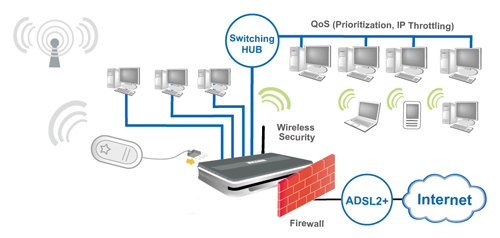Virtual Private Networking
A virtual private network (VPN) extends a private network across a public network, such as the Internet. It enables a computer to send and receive data across shared or public networks as if it were directly connected to the private network, while benefiting from the functionality, security and management policies of the private network. This is done by establishing a virtual point-to-pointconnection through the use of encryption connection.
A VPN connection across the Internet is similar to a wide area network (WAN) link between the sites. From a user perspective, the extended network resources are accessed in the same way as resources available from the private network.

WebRoam UTM Firewalls provide secure remote access for offsite employees to the network by offering multiple types of virtual private network (VPN) tunnels. IT administrators have the option to setup OpenVPN SSL and IPSec VPNs.
User secure remote access
WebRoam IPSec and SSL OpenVPN tunnels provide clientless remote access to your corporate data for individual access anywhere and anytime.
Site-to-Site secure tunnel
WebRoam IPSec and SSL OpenVPN tunnels provide site-to-site tunnels to connect branches to headquarter office securely through public network.
WebRoam Secure VPN protocols include the following:
OpenVPN
Transport Layer Security (SSL/TLS) can tunnel an entire network's traffic (as it does in the OpenVPN project) or secure an individual connection. WebRoam provide remote-access VPN capabilities through SSL. An SSL VPN can connect from locations where IPsec runs into trouble with Network Address Translation and firewall rules.
OpenVPN
Transport Layer Security (SSL/TLS) can tunnel an entire network's traffic (as it does in the OpenVPN project) or secure an individual connection. WebRoam provide remote-access VPN capabilities through SSL. An SSL VPN can connect from locations where IPsec runs into trouble with Network Address Translation and firewall rules.
IPsec
Internet Protocol Security (IPsec) standards-based security protocol is also provided by WebRoam Unified Threat Management. Its design meets most security goals: authentication, integrity, and confidentiality. IPsec uses encryption, encapsulating an IP packet inside an IPsec packet. De-encapsulation happens at the end of the tunnel, where the original IP packet is decrypted and forwarded to its intended destination.
In the graphic below, the areas in blue indicate what a VPN system will protect users against. Areas not marked in blue are not protected by the VPN.

WebRoam supports PEM, PKCS12, and Certificate Signing Request (CSR) certificates.
Webroam UTM OpenVPN server supports authentication types of PSK (username and password), X.509 certificate, and X.509 certificate & PSK (two factor).






